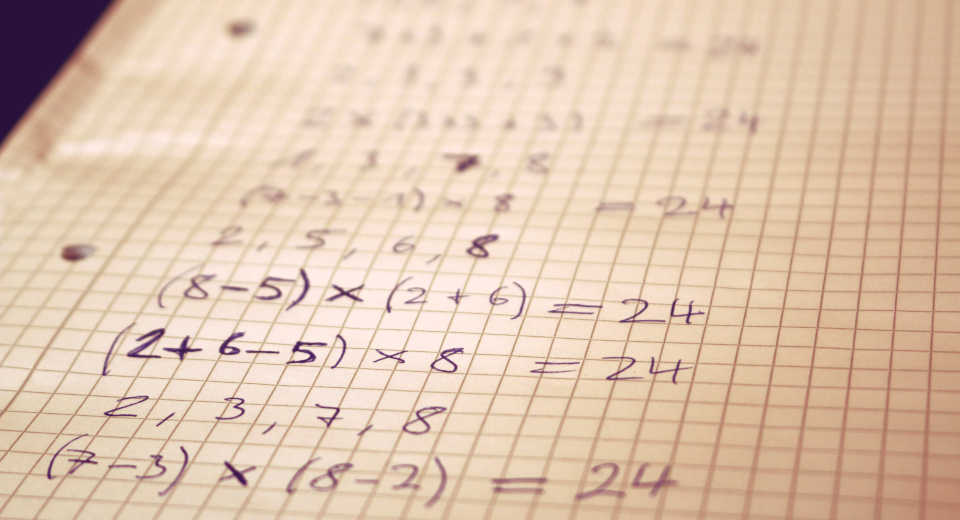With brains to victory – many game lovers love it logical! For these 5 logic games for adults you need nothing more than pen and paper.
Whether it’s checkers, chess, chess or Go –, more than a few passionate board game players want to compete against each other in games using the weapons of the sharp mind. Such players clearly prefer games that require logical thinking and analytical reasoning. But all-rounders, who can certainly do something with games with a strong luck component, also appreciate the variety.
After we already presented 5 logic games for children, for which you don’t need any game material except pens and paper, here is the counterpart: 5 logic games for adults.
5 Logic Games for Adults
For some of these logic games for adults you need squared paper, for one of the games crayons are good, but not necessarily necessary. Most of the games are optimal for 2 players.
1. Cheese Box
Number of players: 2 – 4 players.
First draw a rectangle of any size on squared paper. For beginners, one of 8 x 12 boxes is suitable. (Advanced players can also draw differently shaped squares).
The players may now take turns drawing a line that traces the edge of a box. Whenever a player encloses one or more boxes with a line, they belong to him and he marks them with his symbol (e.g. cross, circle, plus, slash). In addition, he may and must draw another line.
Whoever has captured the most boxes at the end wins the game!
2. Sprouts / Peruvian Mole

Number of players: 2 players
Sprouts, also called Peruvian Mole, seems simple at first glance. But the game invented by 2 mathematicians has it all and is more complex than you might think at first…
These are the rules:
- Paint any number of dots on a sheet of paper. (Start with small numbers first.)
- The players take turns, who starts is drawn by lot.
- A player makes a move by drawing a line from a point to a point. It can be a different point or the same point, which then makes a kind of loop. To finish the move, the player draws another dot on the line just drawn. (This must not be at the end of a line, i.e. on another point).
- A line may not cross or touch another line or a dot that has already been painted.
- A maximum of 3 line ends may converge in one point.
- The winner is the one who makes the last valid move.
A game with n points as the initial situation ends after at least 2n, at most 3n – 1 moves.
Variants
In the so-called Misère variant of the game, the player who makes the last move loses.
In Black-and-White-Sprouts, a player may decide whether or not to put a point on the line.
Brussel Sprouts (“Brussels sprouts”) is played by making crosses instead of points. The ends of the cross give the lines and 4 converging lines are also allowed.
Another variant explained here in English is called Antwerp Sprouts, which is played with dots in different colours.
3. Mastermind as a Paper Game
Number of players: 2
This game is certainly known to many as a purchased version, it is perhaps the most popular of the logic games for adults. But it can also be played quite simply with just pen and paper. The basic idea is that each player thinks up a code and the other tries to guess it in as few attempts as possible. For each guess, you get feedback from your opponent. Through logical deduction, you can then get closer and closer to the solution.
The code consists of a sequence of 4 coloured dots, whereby each dot can have one of 6 colours, which may also be repeated. So there are 6 to the power of 4 = 1,296 possibilities. If you don’t have any coloured pencils at hand, you can simply specify 6 symbols instead, e.g.: +, *, ~, #, &, §.
Each player gets a sheet of paper, draws their code at one end and then covers it up, e.g. by folding it over. It’s best to memorise it right away, or draw it for yourself on a cheat sheet. Then each player is allowed to draw a series of coloured dots or symbols on the sheet in front of the crease: the first attempt to guess the code.
This is now evaluated again by the other player. Next to the attempt, he paints up to 4 scoring symbols. A scoring symbol can be ? or ! Each exclamation mark stands for a point that is both the right colour and drawn in the right position. Each question mark represents a dot that has the correct colour but is in a different position in the code.
Caution!
- Each point is scored only once.
- The order of the scoring symbols is notrelated to the order of the points/symbols in the code.
Example:
Anika has the secret code: Blue Red Green Blue
Alex guesses the attempt: Blue Blue Yellow Red
Anika’s score for the attempt: ?!?
Explanation: For the first blue dot on the far left, Alex gets a ! because it is absolutely correct. For the second blue and the red dot he gets a ? each, because there is a red and another blue dot in Anika’s code, but at different positions.
Alex does not know which points the score refers to. He could, for example, assume that yellow in 3rd place is the one hundred percent correct point and paint this in his second attempt.
In Mastermind, there is a little bit of luck involved, but the main thing is to get closer and closer to your opponent’s code by interpreting the scores logically until you have cracked it.
Tip: Real mastermind geniuses can then also increase the code length or the number of colours (symbols) to increase the level of difficulty.
4. Make 24

Number of players: 1+ players.
For this game, children should already have a good command of basic arithmetic. First, four numbers between 1 and 9 are drawn by lot. Now it is a matter of who can first generate the number 24 from these numbers using only the four basic arithmetic operations (+, – , ×, / ). Brackets are also allowed, but not combining several digits to form a multi-digit number. Each number must occur exactly 1 time.
The winner is the first person to present a solution!
Theoretically, you can also play the game alone and then time how quickly you come up with solutions.
Example: Given are the numbers: 2, 5, 7, 9
Solution: 5 x 7 – 2 – 9 = 24
Note: There are 495 possible number combinations, but 91 of them have no solution. Therefore, it is best to set a maximum time limit of 5 minutes. You can check if there is a solution here.
5. Paper Football
Number of players: 2.
For this game too, first draw a rectangular square on squared paper. The length and width should have an even number of boxes, e.g. 10 x 8 boxes. As with a real football field, 2 goals are added, usually by adding 2 x 1 boxes in the middle of the short sides. A dot is placed exactly in the middle of the field to mark the football at the beginning of the game.
Now the players are allowed to take turns playing the ball by drawing a line from its position to an adjacent point on the grid. Horizontal, vertical and also diagonal moves are allowed.
However, the following rule applies: if the football is played on a point that is already connected with lines, the ball bounces, i.e. it must or may be moved at least once more. Strategically shrewd players can take advantage of this property to move the ball far ahead. The boundary of the playing field counts as drawn lines: a ball can also bounce here.
The winner is the player who can get the ball into the opponent’s goal. If the ball lands at a point from where it can no longer be played, this is considered a draw.
Have fun playing and pondering these logic games for adults!!!! 😀
While you’re here, have a browse through our game tips or other ideas for friends. By the way, for all those in voluntary or imposed quarantine, we have a whole 100 tips against boredom at home!
Do you like Greatime? We’d love your Like on Facebook and we’re also on Instagram! It’s also a great way to keep up to date with our latest tips and ideas!
*Transparency is important to us: This article contains so-called affiliate links. This means that if you order products through it, we may receive a small commission without it costing you a single cent more!

![5 Logic Games For Adults For Which You Only Need Pen And Paper [Uber En="A*game*called*Cheese*box*in*German*is*one*of*the*most*popular*logic*games*for*adults,*for*which*you*only*need*pens*and*paper" De="Käsekästchen*ist*eines*der*beliebtesten*Logikspiele*für*Erwachsene,*für*die*man*nur*Stifte*und*Papier*benötigt"]](https://greatime.de/wp-content/uploads/2020/08/logikspiele-fuer-erwachsene-kaesekaestchen.jpg)
![Uber En Quot Truth Or Dare Tasks For Teens Quot De Quot Wahrheit Oder Pflicht Aufgaben Ab 12 Quot [Uber En="Discover*here*101*funny*truth*or*dare*tasks*for*teens." De="Entdecke*hier*101*witzige*Wahrheit*oder*Pflicht*Aufgaben*ab*12."]](https://greatime.de/wp-content/uploads/2022/10/wahrheit-oder-pflicht-aufgaben-ab-12.jpg)
![Uber En Quot The German Classic Skat Card Game Quot De Quot Der Kartenspiel Klassiker Skat Quot [Uber En="In*the*Skat*card*game,*you*have*to*know*some*rules*and*understand*the*bidding." De="Beim*Kartenspiel*Skat*muss*man*einige*Regeln*kennen*und*das*Reizen*verstanden*haben"]](https://greatime.de/wp-content/uploads/2016/09/skat-regeln.jpg)
![Uber En Quot Drinking Game Never Have I Ever Quot De Quot Trinkspiel I Never Quot [Uber En="In*the*drinking*game*never*have*I*ever*you*need*good*questions*to*make*the*game*fun" De="Beim*Trinkspiel*Ich*hab*noch*nie*braucht*man*gute*Fragen,*damit*das*Spiel*Spaß*macht"]](https://greatime.de/wp-content/uploads/2017/07/trinkspiel-ich-habe-noch-nie-fragen.jpg)